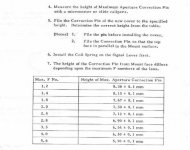I have a brassy '84 Olympics F1N, had a nicer condition plain F1N but sold that as I'm a nerd about the LA Olympics memorabilia. Also have a really lightly used F1n. They both feel nice, hard to say which is "better," mostly down to your preferences.
I don't use the slow speeds much, so running the F1N without batteries does pretty much what I need it to. Came with a plain prism, I bought an AE finder separately and sold it off. I prefer using the F1N with the grip, especially if I'm using one of my heavier lenses, just fits my fairly large hands better that way.
As for lenses, I've been extremely impressed with the 24/2. Had a 35/2.8 for a while, quite nice but I had too many 35s including a nice SMC Takumar I can use on the Canons with the factory adapter (also use that with an 85/1.8 Takumar). The 50/1.4 is excellent of course, I've seen some sample variation so just make sure to shoot with what you pick up and confirm it works for how critical you may be of slides/scans/prints/whatever you are doing with it. Depending on your use, you may want to look at the Tamron Adaptall-2 line up, I have a 300/2.8 that was half price compared to the Canon 300/2.8L and works fine for my use. I'm sure the FD is a better lens but I don't have the budget for it. I'll swap it out for the white lens eventually. You can also get into some very long lenses for relatively cheap with this system, the old FL 400/600/800mm lenses with their focusing mount works just fine. I luckily happened onto the 1200mm f/11 lens head with a focusing mount for dirt cheap on Craigslist, and it's a lot of fun to go and try to use that thing but the shorter lenses would be much more useful.
The VF on the OM4Ti which I had for a bit then sold to a buddy seemed to be a bit brighter but I haven't done a direct A/B comparison with similar lenses so can't say for sure.
Any of them are fun, just buy the best condition you can or wait for the super cheap deals that pop up from time to time.




